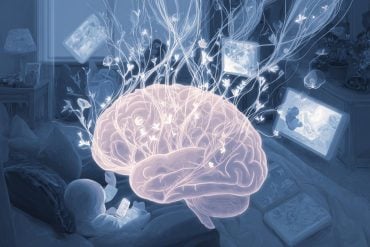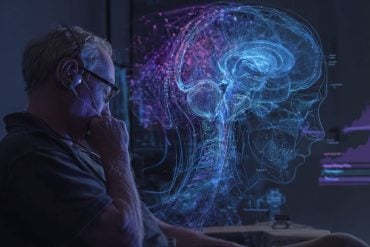Summary: A new review of 38 studies confirms that simply viewing visual art can significantly enhance wellbeing, regardless of whether it’s done in a gallery, hospital, or even virtually. The research highlights art’s impact on eudemonic wellbeing—a sense of meaning, personal growth, and purpose in life.
From Van Gogh’s Starry Night to abstract modern installations, a wide range of art forms were shown to produce positive effects. The findings offer a compelling case for integrating art into mental health strategies as a low-cost, accessible tool to support emotional health.
Key Facts:
- Meaningful Benefits: Viewing art improves eudemonic wellbeing, enhancing life meaning and personal growth.
- Widespread Impact: Positive effects were observed across hospitals, museums, and virtual settings.
- Policy Implications: Researchers call for art to be integrated into public health and mental wellness programs.
Source: TCD
The simple act of looking at a piece of visual art can boost your wellbeing, a new research study has found, and this benefit can be gained in a hospital setting as well as an art gallery.
Artworks which were included in the review include famous pieces such as The Scream by Edvard Munch, The Starry Night by Vincent Van Gogh, and other pieces of modern and contemporary art.
The authors of the review have called on healthcare providers and policy makers to integrate art into mental health strategies as a low-cost and easily-accessible resource.
Previous research has suggested that viewing art might influence mood or stress, but the research was limited and inconsistent, they say.
This study examined decades of scattered research, providing for the first time a clear and comprehensive overview of when, where and why art viewing is used to promote wellbeing.
The review of 38 previously published studies covering a total of 6,805 participants was conducted by team of psychologists from University of Vienna, Trinity College Dublin, and Humboldt University of Berlin.
It has been published this week in The Journal of Positive Psychology.
The study found that viewing art can improve eudemonic wellbeing, this is wellbeing associated with meaning in life and personal growth.
These benefits were observed in a variety of locations—in museums and galleries as well as clinics and hospital settings and also through the medium of virtual reality.
A wide range of art types including figurative, abstract, modern and contemporary paintings, photography, sculpture and installations were found to boost wellbeing.
“People often think of art as a luxury, but our research suggest that viewing art—whether as a hobby or as a targeted health intervention—can meaningfully support wellbeing,” said MacKenzie Trupp, lead author and researcher at the University of Vienna and Radboud UMC, Donders Institute.
“By reframing art as a low-cost, accessible wellbeing resource, this research opens up exciting possibilities for integrating art into everyday environments and public health strategies.”
Claire Howlin, Assistant Professor, School of Psychology, Trinity, added: “While the mental health benefits of creating art have been widely explored, the impact of viewing art has been under-researched and undervalued.
Yet visual art is present and accessible in everyday spaces—museums, galleries, hospitals, and at home. Understanding its effects can unlock new avenues for promoting wellbeing through everyday encounters with art.
“Since 2019 the WHO has recommended that creative approaches are used alongside routine clinical care. Art can satisfy people’s need to search for meaning in life, build self-esteem, and develop positive identities which are important factors for coping with the chaos of life.
“Departments of health and arts councils across Europe are looking for high quality evidence to identify which types of arts can be used for each type of medical outcome. This review will help to plan larger scale studies in the future.”
The study also found a lack of methodological inconsistency across previous studies, prompting the creation of a new set of guidelines—Receptive Art Activity Research Reporting Guidelines (RAARR)—to standardise future research.
Funding: This research was funded by the European Union Horizon 2020 ART*IS project.
About this art and wellbeing research news
Author: Fiona Tyrrell
Source: TCD
Contact: Fiona Tyrrell – TCD
Image: The image is credited to Neuroscience News
Original Research: Open access.
“The impact of viewing art on well-being—a systematic review of the evidence base and suggested mechanisms” by MacKenzie Trupp et al. Journal of Positive Psychology
Abstract
The impact of viewing art on well-being—a systematic review of the evidence base and suggested mechanisms
Art viewing is increasingly seen as having benefits for well-being. Despite this, evidence is scattered, and the siloed nature of past research stunts our mechanistic understanding.
To address this, we systematically reviewed (CRD42022296890) the evidence of the effects of art viewing on well-being, summarised the characteristics of art viewing experiences, study designs, and results, and thematically analysed suggested mechanisms.
CINAHL, EBSCOhost, Scopus, and PubMed were searched, 3893 abstracts were screened, and 38 papers were included (N = 6805 participants).
Quantitative synthesis revealed a diversity of settings, schedules, activities, and outcomes.
Thematic analysis revealed affective, cognitive, social, self-transformative, and resilience-building mechanisms that were often context-dependent.
While convergent evidence exists for eudemonic well-being, we found no strong support for other well-being outcomes.
More rigorous methodology and a focus on activity components and mechanisms is needed.
We make recommendations and introduce the new Receptive Art Activity Research Reporting Guidelines (RAARR, https://osf.io/qjg72/) to support future research.







